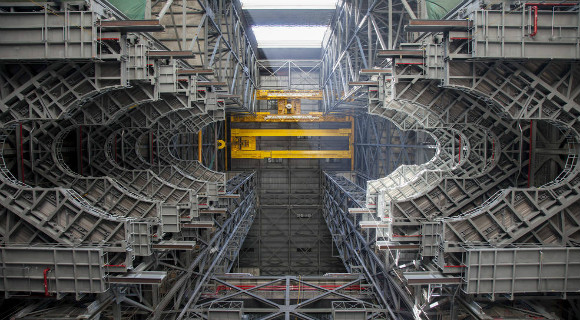VIDEO: New Work Platforms For NASA’s Space Launch System Rocket Reaches Halfway Point
By Linda Herridge, NASA's Kennedy Space Center // July 28, 2016
PLATFORMS WILL SUPPORT SLS and Orion
ABOVE VIDEO: Back in May, the first new work platforms for NASA’s Space Launch System (SLS) were powered on and tested in the Vehicle Assembly Building High Bay 3 at the agency’s Kennedy Space Center in Florida. This week, the new platforms inside the VAB building reached the halfway point. (NASA Video)
BREVARD COUNTY • CAPE CANAVERAL AIR FORCE STATION, FLORIDA –Installation of new work platforms for NASA’s Space Launch System (SLS) rocket and the journey to Mars reached the halfway point this month inside the Vehicle Assembly Building (VAB) at the agency’s Kennedy Space Center in Florida.
Prior to rolling out to the launch pad, the rocket and Orion spacecraft will come together in the VAB for processing and assembly. Five of the ten levels of platforms are in place in High Bay 3, all part of the massive amount of work going on inside the iconic building to accommodate SLS and Orion.
“This is a key milestone for NASA and the Ground Systems Development and Operations Program,” said Mike Bolger, GSDO program manager at Kennedy.
The F North and South platforms were lifted by crane from the transfer aisle floor of the VAB, slowly raised into position, and attached to rail beams on the north and south walls of the high bay on July 15 and 19, respectively. The rail beams provide structural support and contain the drive mechanisms to retract and extend the platforms.
When all of the platforms are installed, a total of 20 platform halves altogether, will surround the SLS rocket and Orion spacecraft and provide access for testing and processing for the uncrewed and deep-space missions, including thejourney to Mars.
“This is a significant accomplishment in the production and installation of the platforms for High Bay 3,” said Jose Perez Morales, VAB Element Project manager.

It takes about four hours to lift and install each of the platforms. They weigh between 300,000 and 325,000 pounds, and measure about 38 feet long and close to 62 feet wide. Construction workers with VAB general contractor Hensel Phelps, subcontractors S&R, Steel LLC and Sauer Inc., and the Kennedy Test and Operations Support Contract contractor Jacobs are performing the work.
“This team is working in a historical facility, becoming part of future space exploration and preparing for the journey to Mars,” said Perez Morales. “It is an exciting time to work at the beginning of a NASA program in a facility such as the VAB.”
Located about 192 feet above the VAB floor, the F-level platforms will provide access to the SLS core stage (CS) intertank for umbilical mate operations. Located on Platform F, the “F-1” multi-level ground support equipment access platform will be used to access the booster forward assemblies and the CS to booster forward attach points.
The upper level of F-1 will be used to remove the lifting sling used to support forward assembly mate for booster stacking operations.

“Using the five platforms that are now installed, workers will have access to all of the Space Launch System rocket’s booster field joints and forward skirts, the core stage intertank umbilical and interface plates,” Bolger said.
Standing in the VAB High Bay 3 and looking up at all of the platforms as they are extended is a sight that Bolger is looking forward to experiencing.
“We will be able to see what the outer mold line of the SLS rocket is going to look like and visualize the beehive of activity that will be constant for several months as the rocket and Orion spacecraft are stacked and tested prior to rollout to the launch pad for the first time for a dress rehearsal,” Bolger said.
“It will be one of those moments in our lives that we will never forget!”
Installation of the remaining five levels of platforms should be completed by spring 2017. Testing of the platforms will begin later this year, starting with the lowest platforms, the K-level, and working all the way up to the top, the A-level.
“It’s another giant leap for the GSDO Program as we prepare Kennedy Space Center to support the agency’s journey to Mars,” Bolger said.
CLICK HERE FOR MORE NEWS FROM NASA













